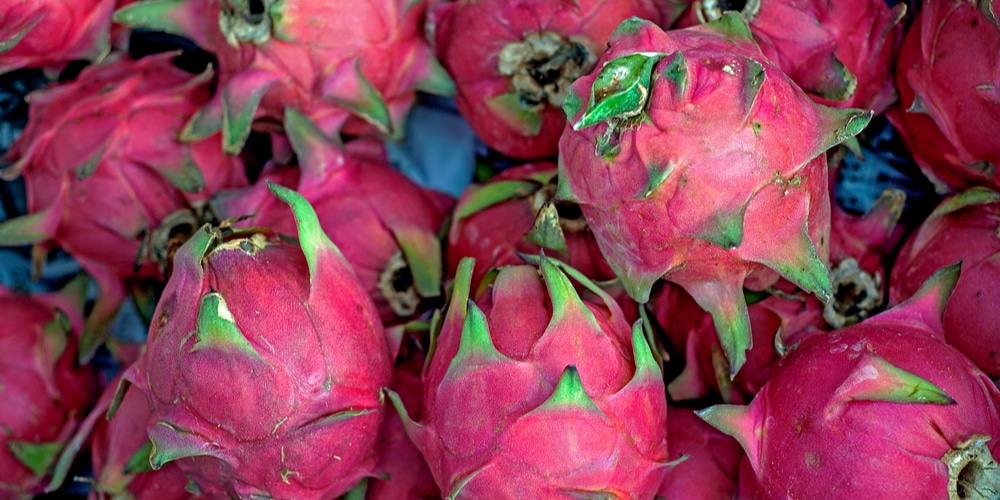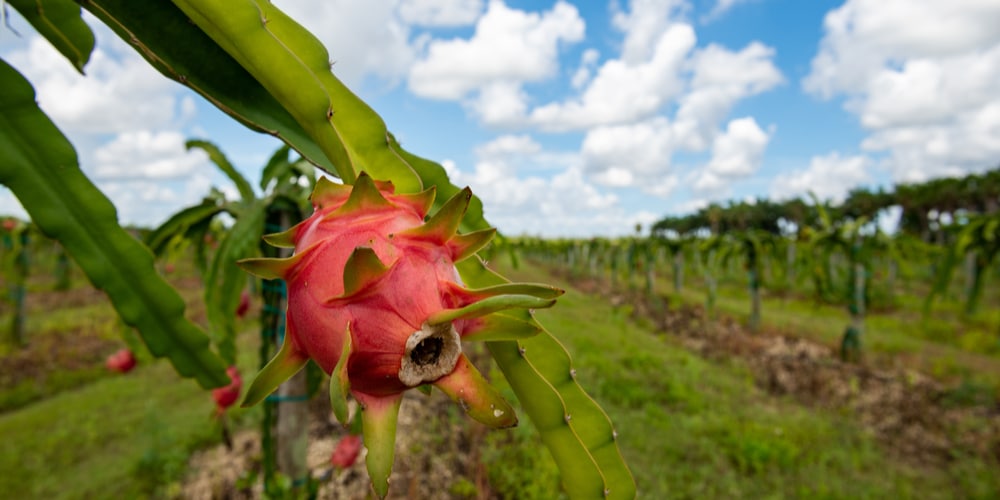Hylocereus undatus is a vine-like plant belonging to the cactus family. Commonly used as an ornamental vine cum a fruit crop, Hylocereus undatus is a terrestrial or epiphytic plant that has a very fast growth rate. It is commonly referred to as Dragon fruit, Christ in the Manger, or night-blooming cereus.
| Botanical Name | Hylocereus undatus |
| Common Name | Dragon fruit |
| Plant Type | Perennial |
| Flower Color | White, scented, 25-30 cm, bell-shaped flowers |
| Size When Mature | 157.5in by 79in |
| Bloom Time | Late Spring, Early Summer |
| Sun Requirements | Full/Partial sun |
| USDA Hardiness Zones | 11 |
| Soil PH Range | Acid, Alkaline, Neutral |
| Soil Type | Chalk/Loam/Sand, Well-Drained |
| Water Needs | Average |
| Native Area | Americas: Nothern South America, Central America |
What you Need to Know About Hylocereus undatus
The fruit of this plant is notably the most beautiful in the Cactaceae family, being quite large, showy, and having a bright red color. The pulp is white with small black seeds that are edible. And the flower is so beautiful that it has earned the plant names like “Queen of the Night” or “Noble Woman”.
The night-blooming cereus has 3-sided, fleshy stems that are usually jointed and can attain a maximum length of 6m or 20ft. Thanks to the aerial roots, this plant can grow or climb with ease, provided there are surfaces to support its growth.
This plant usually produces large, white flowers that are unequivocally beautiful. In regions with temperate climates, the flowers – 14in. (35cm) long – typically appear during the late spring through early summer.
Tropical climates seem to favor this plant, in that it can achieve an average of 4-6 fruiting/flowering cycles every year.
The shortlived fragrant flowers of this plant will open only at night and last for just a single night. It’s only when the flowers have been pollinated that the plant produces the fruit, which takes about 4 weeks to ripen.
Quick Facts:
- Hylocereus undatus is a cactus plant that is also known as the Queen of the Night or night-blooming cereus.
- It is native to the Americas, even though it is now grown in tropical regions around the world.
- The dragon fruit is a night-blooming plant, and the flowers only last one evening
- The fruit of the plant is edible and often used in desserts or eaten fresh
How to Care for Hylocereus undatus
Here’s everything you need to know about growing and caring for a thriving Hylocereus undatus:
Light
The plant prefers full sun but can tolerate partial shade. If growing indoors, place the plant closer to a window that receives bright, indirect sunlight.
During summer, you can take the plant outside and place it in an area that has filtered light. Make sure to protect your plants from direct sunlight, especially during the afternoon summers.
Water and Soil Needs
One thing that you will love about this plant is that it’s not fussy when it comes to soil conditions. All you have to do is to ensure that the soil that you are using is well-drained and supplemented with lots of organic material. The night-blooming cereus does best in alkaline, neutral, and acidic soils.
The Christ in a Manger plant can tolerate drought conditions very well. However, it’s important to keep the soil moist when during the spring and summer months, or simply from the flowering to harvesting period. Keep in mind, however, that being a cactus, this plant requires less water compared to other houseplants.
Temperature Requirements
Hylocereus undatus survives best in hardiness zone 11 and heat zones 10-12. Temperatures that exceed 100 degrees Fahrenheit are said to damage the plant.
It’s recommended to move the plant outdoors if the indoor temperature hits 80 and dropping. Whenever you take your plant outside, however, always remember that a temperature that is close to 100 degrees is disastrous to these plants.
For this reason, whenever you move your plant from an indoor setting to an outdoor area, it’s critical to ensure that it’s under a partially shaded area whenever the temperatures reach 90 and above.
Fertilizer
The best fertilizer to use on a dragon fruit is a 15-30-15 fertilizer, after pruning during the first week of March. Make sure to keep watering the plant after pruning, to stimulate the plant to produce new growth.
Common Diseases
Hylocereus undatus is a hardy plant that will require very little care when it comes to managing pests and diseases. That’s in consideration that there are very few reports on diseases that affect the H. Undatus. There, however, are chances of encountering stem rot that is caused by Xanthomonas campestris. Dothiorella occur has also been known to cause brown spots on fruits.
Hylocereus undatus Propagation
The plant can be propagated from stem cuttings or seeds.
You may want to pay attention to the fact that propagation from seeds is less reliable, hence it will require lots of patience. That’s mainly because it can take up to 7 years to get your plant to produce fruit. For this reason, stem cuttings are the better option. Cuttings typically grow quickly, producing fruit in as little as 6-9 months after propagation.
To propagate from stem cuttings:
You will need a sharp knife to take a 6 to 15-inch cutting from a healthy stem. You will want to treat the base of the stem with a fungicide. Before applying the fungicide, make a slanted cut to the base of the stem. Place the stem in a dry, shaded area and leave it to dry for a week after which you should dip it into a rooting hormone before planting it.
If you’d rather propagate using seed:
Get an H. undatus fruit and cut it in half, then scoop out the pulp with the seeds in it. Next, you will want to place the pulp in a bucket of water to separate the seeds from the pulp. Let the seeds dry overnight after placing them on an absorbent material, preferably a paper towel.
After the seeds have dried, sprinkle them onto a well-draining seed starting mix spread evenly on a tray or a similar flat surface. Next, cover the seeds lightly with the same medium that you’ve dropped them on, and then use a spray bottle to moisten the surface before covering the entire setup with plastic wrap.
Make sure to keep the soil moist throughout the 15-30 days that your seeds need to start germinating. Once the seeds have germinated, transplant them to grow pots.
Related Article: Can You Grow Dragon Fruit in Florida?


